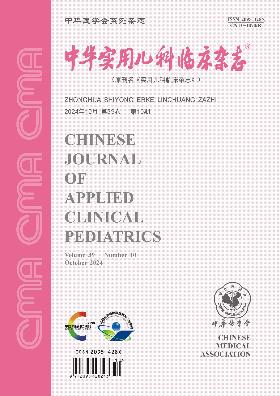左旋西孟丹治疗先天性心脏病患儿术后低心排血量综合征的疗效
Q4 Medicine
引用次数: 0
摘要
目的探讨左西孟丹治疗先天性心脏病(CHD)患儿术后低钙输出综合征(LCOS)的疗效。方法收集2018年1-12月阜外华中心血管病医院儿童心脏中心CHD患者术后发生LCOS的临床资料。在传统血管活性药物未能缓解LCOS的患者中,观察了持续输注0.1μg/(kg·min)左西孟丹的疗效。此外,还观察了机械通气时间、ICU停留时间、死亡率、射血分数(EF)和中心静脉血氧饱和度(ScvO2)在输注左西孟丹时和输注后48小时的变化,以及心率(HR)、收缩压(SBP)、血管活性药物评分(VIS)和乳酸在输注右西孟丹后3小时、6小时、12小时的变化,记录输注后24小时和48小时。结果29例,其中男性17例(58.6%),女性12例(41.4%),中位年龄2(0.5,40.0)个月,中位体重4.7(2.6,13.5)kg,中位机械通气时间109.5(42.5367.0)h,ICU住院时间187.5(83.446)h,死亡1例(3.4%),HR水平(173次/min、176次/min、175次/min、173次/min和170次/min、170次/min)和乳酸水平(4.72 mmol/L、4.65 mmol/L、4.34 mmol/L、3.79 mmol/L、3.28 mmol/L、2.74 mmol/L)在输注后逐渐下降,两组在输注开始与输注后48小时的差异有统计学意义(P=0.029);SBP在输注后的不同时间点先下降后上升(74mmHg、70mmHg、71mmHg、73mmHg、74mmHg,75mmHg,1mmHg=0.133kPa),VIS在输注前的不同时间段先上升后下降(26分、27分、27得分、26分、25分、25得分),结论左西孟丹用于治疗婴幼儿冠心病术后LCOS,可增加EF,增强心肌收缩力和全身组织灌注,改善预后。关键词:婴儿;先天性心脏病;低心输出量综合征;Levosimendan本文章由计算机程序翻译,如有差异,请以英文原文为准。
Efficacy of Levosimendan on postoperative low cardiac output syndrome of infants with congenital heart disease
Objective
To investigate the efficacy of Levosimendan in the treatment of postoperative low cadiac output syndrome (LCOS) in infants with congenital heart disease (CHD).
Methods
Clinical data of patients with CHD developed postoperative LCOS in the Children Heart Center of Fuwai Central China Cardiovascular Hospital from January to December 2018 was collected.In patients that traditional vasoactive drugs failed to alleviate LCOS, the efficacy of continuous infusion of 0.1 μg/(kg·min) Levosimendan was observed.Besides, the mechanical ventilation time, ICU stay time, mortality, the changes of ejection fraction (EF) and central venous oxygen saturation (ScvO2) at the infusion of Levosimendan and 48 h after infusion, as well as the changes of heart rate (HR), systolic blood pressure (SBP), vasoactive drugs score (VIS) and lactic acid at the infusion of Levosimendan and 3 h, 6 h, 12 h, 24 h and 48 h after infusion were recorded.
Results
There were 29 cases, including 17 males (58.6%) and 12 females (41.4%), with median age of 2 (0.5, 40.0) months, median body mass of 4.7 (2.6, 13.5) kg, median mechanical ventilation time of 109.5 (42.5, 367.0) h, ICU stay time of 187.5 (83, 446) h, and 1 case died (3.4%). EF (48% vs.52%) and ScvO2 (53% vs.58%) increased 48 h after infusion, and the differences were statistically significant (all P<0.01). HR level (173 times/min, 176 times/min, 175 times/min, 173 times/min, 170 times/min, 170 times/min) and lactic acid level (4.72 mmol/L, 4.65 mmol/L, 4.34 mmol/L, 3.79 mmol/L, 3.28 mmol/L, 2.74 mmol/L) gradually decreased after infusion, and the differences of both between the beginning of infusion and 48 h after infusion were statistically significant (P=0.029); SBP decreased and then increased (74 mmHg, 70 mmHg, 71 mmHg, 73 mmHg, 74 mmHg, 75 mmHg, 1 mmHg=0.133 kPa), and VIS increased and then decreased (26 scores, 27 scores, 27 scores, 26 scores, 25 scores, 25 scores) at different time points after infusion, however, the data of both between the beginning of infusion and 48 h after infusion had no significant differences (P=0.294, 0.151).
Conclusions
Levosimendan can increase EF, enhance myocardial contractility and systemic tissue perfusion, thus improving the prognosis, when Levosimendan was applied for the treatment of postoperative LCOS of infants with CHD.
Key words:
Infant; Congenital heart disease; Low cardiac output syndrome; Levosimendan
求助全文
通过发布文献求助,成功后即可免费获取论文全文。
去求助
来源期刊

中华实用儿科临床杂志
Medicine-Pediatrics, Perinatology and Child Health
CiteScore
0.60
自引率
0.00%
发文量
14243
期刊介绍:
Chinese Journal of Applied Clinical Pediatrics ( semi-monthly ) is a core journal of paediatrics under the supervision of China Association for Science and Technology, sponsored by Chinese Medical Association and undertaken by Xinxiang Medical College. Founded in 1986, it is openly circulated both at home and abroad. The journal has several columns, such as Expert Forum, Experimental Research and Paediatric Surgery, which are mainly for paediatric medical workers and medical researchers in hospitals. Its purpose is to reflect the new theories and technologies in paediatric medicine and scientific research at home and abroad, and to promote academic exchanges.
Chinese Journal of Applied Clinical Pediatrics is a source journal of China Science Citation Database (CSCD), a core journal of Peking University, a source journal of Chinese science and technology paper statistics (China Science and Technology Core Journals), a core academic journal of RCCSE, a high-quality scientific and technical journal of China, a high-quality scientific and technical journal of China Association for Science and Technology, and a high-quality scientific and technical journal of China Biomedical Science and Technology Association. We have been published in China Biomedical Literature Database (SinoMed), China Knowledge Network, Wanfang Data Knowledge Service Platform, China Academic Journal Abstracts, Scopus Database, Chemical Abstracts (USA), Japan Science and Technology Agency (JSTA) Database, Copernicus Abstracts (Poland), Abstracts of the Centre for Agricultural and Biological Sciences (CABS) of the United Kingdom, Cambridge Scientific Abstracts ProQuest Database, WHO Medical Journal of the Western Pacific Region (WMPR), and WHO Medical Journal of the Western Pacific Region (WMPR) of the United States. We have been included in dozens of authoritative databases at home and abroad, such as WHO Western Pacific Region Index of Medicine (WPRIM), Ullrich's Guide to Periodicals, and so on.
 求助内容:
求助内容: 应助结果提醒方式:
应助结果提醒方式:


